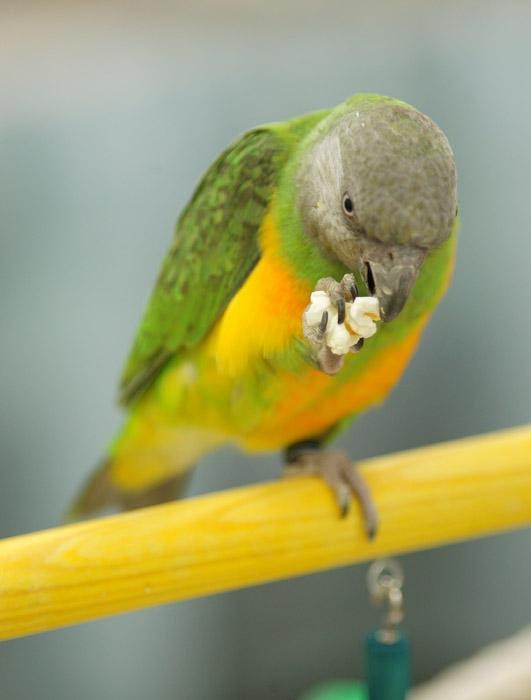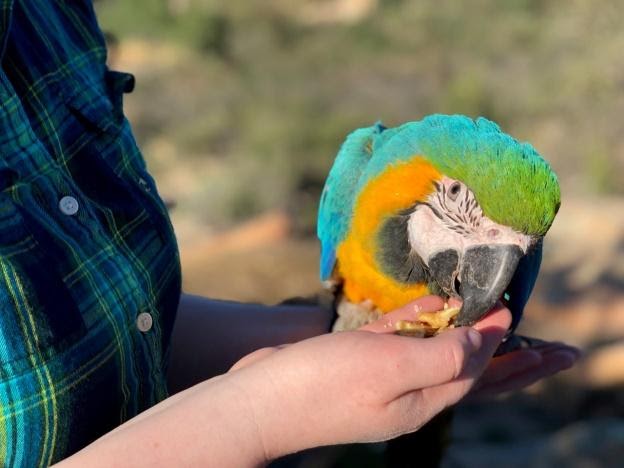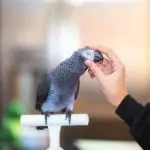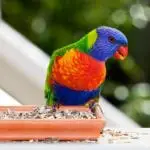
Similar to training pet dogs and cats, training pet birds require patience, time, and skill. And for training and learning new tricks to go smoothly, pet owners use treats. And if you’re looking for the best pet treats, here are ten of the healthiest and the most delicious treats you should prepare for your next training time.
Fresh fruits
Birds will eat almost all kinds of fruits, especially local fruits. But do you know that these creatures also know which fruits are dangerous, toxic, or forbidden to eat? And when it comes to treats, birds will love fruits like ripe mangoes, pomegranates, cantaloupes, bananas, or apples.
These fruits are full of nutrients that your pets will need and will also give them the energy that they need throughout the day. As much as fruits give us vitamin C and A, pet birds also need these vitamins daily for proper functioning.
The trick is to serve the fruits the right way so as you can offer them as treats. For hard fruits like apples, pears, and pomegranates, chop these into smaller pieces. You can remove the seeds or not; it doesn’t matter because birds will eat them anyway.
For small fruits like grapes, berries, strawberries, and dates, just wash them and offer them as is. Large pets like parakeets and parrots will just hold on to these fruits and gobble them up the whole.
When it comes to softer fruits like mangoes, bananas, and cantaloupes, just cut these into small, bite-size pieces and place them in a small dish. Your pet will love to feast on this fruit salad right after your training is done. And why stop there, you can make a real fruit salad medley for your pet by cutting small pieces of fruit, freezing them and placing a dash of cream right before serving. Pampering your pet with some good food will make your bond closer.
Some fruits are also great when they’re dried and slightly sweetened. If you have a drying machine, then you can dry some pieces of oranges, pineapples, kiwis, or berries. After hours of drying, roll these slightly in confectionary sugar. With dried fruit pieces, you can hold on to fruits better and use these when training your pet.
You may also offer fruit jams or preserves on bread. Cut small pieces of bread and dip these in a jam. Prepare ten pieces of fruit jam-covered bread for your session. You can prepare more if you’re up for a longer training session the next time.
Boiled Beans
There are many types of beans, and all these are great sources of protein. These are good for your birds since protein helps heal wounds, repair tissues and help young parrots grow. Beans are also good sources of fiber and thus will improve your pet’s digestion. It will help make it regular, and thus, you won’t have to deal with weird digestion problems like runny stools, constipation, or diarrhea.
You can give raw beans to your pet, but these will be hard because some beans may be toxic to birds when raw. Also, depending on the size of your pet, some may not tolerate large beans like kidney beans or lima beans. So to give beans to pet birds, its best to boil the beans. Try a 15-bean soup in a pot with just enough water and no seasoning or artificial flavors. Once the beans are soft, cool them on the counter. Give a scoop of bean soup to your pet.
Another way to offer beans is to boil the beans in a small amount of sugar. Just like the previous recipe, let the beans soften, and then when these are done, place this on the counter to cool. Serve a tablespoon to your pet right after successful training. You can also offer this sweet treat as a dessert.
Satisfying Sprouts
If you love some sprouts like alfalfa sprouts in your salad, then you can bet that a pet bird loves it too. But be careful when giving any kind of sprout from the grocery or market because some of these may be grown using pesticides. These chemicals can be very toxic to your pet. You can avoid pesticides and other chemicals by growing your sprouts.
With just a dish of soil and some sprouts seeds, just grow them in your kitchen with some water and artificial light. This ensures that the sprouts you serve to your family and your pet are safe to eat.
And how to serve sprouts as treats? Just serve these as they are. Take a few strands and place them in your pet’s food dish. You may add sprouts with other food treats like veggies and fruits too.
Value Veggies
Birds in the wild are known to eat all kinds of fruits, including vegetables. Offer fresh veggies but make sure that these are grown in pesticide, chemical-free soil. Wash these veggies in water, or you can soak these in apple cider vinegar for safety.
You can serve veggies like carrots, broccoli, greens, kale, peas, root veggies, or cauliflower to your pet. Just cut these into small, bite-sized pieces and just serve them. You don’t need to remove the skin too, plus you can mix veggies to create a delicious vegetable salad treat.
Pieces Of Pasta
Pasta comes in all forms, sizes, shapes, and colors, and parrots, and parakeets love them all. You can feed your pet raw or cooked pasta; it does not matter because these birds have powerful beaks to crush raw pasta.
Pasta contains high amounts of carbohydrates that your pet can use for energy. You can serve a small bowl full of different types of pasta, or you can boil some small pieces with chopped veggies. Let this cool before serving to your pet.
You can make pasta more exciting by adding nut butter to boiled pasta to create a healthy and fun snack. Another way is to serve pasta with some spaghetti sauce and cheese. Place this delicious pasta treat in a small dish and watch your pet dive right in.
Pop Some Popcorn
Popcorn is a favorite among birds raw or cooked. Birds consider this a snack and will gladly dive into a bowl of freshly-popped popcorn. But if you want to serve unpopped kernels, boil this in plain water to soften the corn hulls. You may also pop the popcorn using a small amount of oil like coconut oil. You may also add some butter or some cheese powder to popcorn for a real treat.
Bread
You can give your pet all kinds of bread as a treat. If you happen to have leftover breakfast bread, save these in a plastic bag so you can give it to your pet later. Use whole grain bread, which is a good source of fiber.
Bread is also an easy bird feeder. Just tie a piece of bread on your porch or tree and watch wild birds come by to take a bite. You can also add more zest to bread by covering pieces in a jam, in nut butter or peanut butter. Cut the bread in smaller pieces and dip each one in jam or peanut butter. You can hand over small pieces to your pet bird as you train him to perform different tricks.
Nuts
Nuts contain very high amounts of nutrients and thus are very healthy treats for your pet. If you regularly add nuts to your pet’s diet, then your pet will not hesitate to have some for a treat. Nuts like walnuts are special treats. You can also use nuts like walnuts, peanuts, and pistachio nuts as foraging toys. Hide these inside toys, in unlikely areas inside your pet’s cage. Your pet will look for them inside the cage or playpen, and this creates a play challenge for them.
Don’t crack open nuts for your pet. The hard shell of some nuts like walnuts is hard to crack and thus creates a form of exercise for your pet. In the wild, parrots will use their strong beaks to crack open these hard shells. But if they find a nut that they can’t open because its too hard, you can offer help by cracking these using a nutcracker.
Serve only clean, unsalted nuts and not the spicy, salty, or sweet variety. What’s great about nuts is that you can buy a lot of it, freeze it and use it after many weeks and it won’t expire. You can use nuts for training in many ways too.
For instance, you can place nuts in sweet syrup and dry them on a drying rack. This will coat the nuts in a thin layer of sweet sugar and give it a unique taste. This can work with peanuts, pecans, walnuts, and more. You may also toast nuts as well. Just don’t add any salt or spice, and you’re ready to give these as treats.
Cereals or grains
Wild birds are known as pests when they descend on a field of grain and eat to their hearts’ content. Birds just love cereals or grains and will gladly eat them. But good news, you don’t have to worry about your pet eating too many grains or cereal because these are very nutritious and can be very good for your pet.
Cereals and grains offer nutrients that other foods may lack. Whole grains, for instance, are dependable sources of protein and carbohydrates. Just some of the cereals you must serve your pet include quinoa, oats, or the popular and handy Grain Bake.
You can serve cereals and grains plain. Just take a few pieces and give it to your pet as a reward. But you can make cereals more interesting by adding honey. Take a small amount of cereal and place these in honey. Use a spoon to remove the cereal, make a small ball, and dry it. This is a honey cereal ball treat that you can readily give your pet as a reward for his good behavior and for following your commands.
Peppers
Somehow, birds can eat many chili peppers and won’t feel hot at all. They lack the particular pain receptors that are supposed to pick up on a chili peppers’ hot bite. This is why when you serve peppers, your feathered friends will even thank you for it.
There are so many pepper varieties to choose from as well. You can try chili peppers or banana peppers. Red or green peppers, your pet bird will love it. And you can serve peppers raw as long as you wash them first. You may also let the peppers soak in apple cider vinegar and water for a few minutes and then give these to your pet.
It’s also easy to reward your pet with peppers. Just take one in your hand and place it in its mouth. You may zest this treat a bit and dip one pepper in nut butter.
Other birds treat ideas to check out

Raisins and dates
Dried raisins, prunes, and dates are delicious treats for birds. All the sweet and tangy flavors locked in one tiny bit. It’s also easy to buy raisins straight from the shelf of any supermarket or convenience store. These foods are easy to give to your pet as well. You can hold on to a piece and just let it gobble from your hand.
Raisins and dates are perfect sources of much-needed vitamins and minerals. You won’t feel guilty about feeding your pet with these treats at all.
Sweet potatoes
Sweet potatoes are nutritious, and when cooked well, your pet bird will likely screech with joy. Sweet potatoes can be given raw, just cut it into small pieces. But you may also cut these into small pieces and boil them, skin and all. When these have softened, remove from heat and just let these cool for a bit.
You may now give this to your pet but do so in moderate amounts. You can also add some sugar or dip each in nut butter or peanut butter.
Corn on the cob
Aside from raw corn and popcorn, you can give your pet bird a very special treat by handing him a piece of cooked corn. It will eat well and love the treat plus; it will love picking food from the cob and by perching on the cob.
When you boil corn, don’t place spices like salt and pepper or butter in the water. Just let corn cook plainly. And make sure that everything is at room temperature before the food is given.
Cookie bits
Make bits of leftover cookies a treat for your pet. You can turn these bits into small balls and freeze them. You can also cut up cookies and present them to your pet.
Important tips in giving treats

1) Too many treats
Anything in excess is not good. This is also true for giving too many treats. This is why you must first prepare your treats and arrange them on a plate. Arrange a definite number of treats you want to give, like ten treats for three commands. One of your pet birds getting the command and another two for performing the command well. By bringing only a definite number of treats, you’ll be able to control your generosity and avoid overfeeding your pet.
2) Treats only for good behavior
Avoid the urge to give treats for nothing. Consider every kind of treat as a special kind of food, and this is reserved for good deeds, nothing more. If you give your pet a treat for nothing, it will get confused with your behavior.
3) Treats can be bad for your pet’s health
Even natural treats like veggies, fruits, and nuts can be bad for your pet’s health if you give them too much. Sure your pet was able to follow your command perfectly; however, you can’t just give treats time and again. Your pet can become overweight or obese, and this can lead to terrible complications like inactivity, weakness, and more. Although it’s not completely studied, pet birds may also suffer from obesity, and this can greatly affect their health and overall wellness. It’s best to control your pet’s food intake especially its intake of treats to counter obesity.
4) Replace treats with other forms of praises
When your pet is a stellar student, and you can’t give too many treats, then you must transition from treats to other forms of praises. You can resort to scratching its head, petting its back, massaging its back and wings, or simply kissing it on the top beak. You can also show your appreciation by talking to your pet and praising it directly. Tell him what a good boy he is or tell him how amazing he was after performing a difficult treat.
You may also reward your pet with his favorite toy, rope, or hoop. Toys will also work as a treat, especially if your pet bird has a favorite toy he loves to play with.
5) Preserve your homemade treats
Making a batch of homemade treats like dried fruit and sweetened nuts is a rewarding thing knowing that you’ll have some treats handy just in case. But how to preserve these tempting treats?
You can place these in resealable baggies and freeze them. By the time you need them, you can microwave a few of your treats and serve. You can also place preserves and jams in jars; just make sure to label these. Include the date when it was made and the kind of jam or preserve it is.
Just like keeping food to last longer, you can also place dried food like dried nuts, fruits, and cereal in dry plastic containers with covers. You can also use mason jars, these are resealable, easy to keep, and you can find these almost anywhere.
But if you want to serve only fresh treats, then just make and serve treats on the same day. Make only a small batch of treats so you won’t have to worry about storing them.
6) Should you give commercially –made treats
You might say, why do I even have to bother with making my treats when I can buy commercially-prepared ones? Yes, you can save time and effort of making treats and just use ones from the store, but there are a few problems with commercially-prepared treats.
Some of the ingredients in commercially-prepared products are not natural, meaning these are full of chemicals that can harm your pet. Most may contain preservatives to prolong shelf life, and this can greatly affect your bird’s health.
Some products may also have smells, flavors, and tastes that your pet may dislike. Most birds are just into flavorless treats. You will only end up spending money on things that your pet may not like.
Also, some treats may have a lot of calories, which can lead to obesity for a bird, which has very little activity. Commercial treats may save you time but may have a lot of negative effects on your pet’s health. You need to choose the company and the brand wisely so you can get a reliable and healthy alternative to homemade treats.
7) Growing produce at home for your pet bird’s treats
If you can grow fruits or veggies at home for your family, why not grow food for your pet bird? The best thing about growing your produce is that you don’t need to worry about pesticides, chemicals, and other dangerous toxins that may be found in food. Growing without this is possible, and it’s happening everywhere.
When you grow your food, you’ll save money and effort, plus you can guarantee the health of your family and your pets. What kinds of fruits and veggies can you grow? If you have a small garden or even a garden on your porch, you can grow succulents, tomatoes, carrots, leafy greens, and sprouts. With a large garden, you can tend to large trees that will grow bountiful fruits. All these will be worth the effort.

